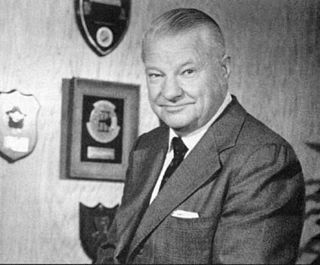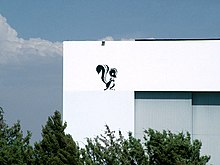
The Lockheed Corporation was an American aerospace manufacturer. Lockheed was founded in 1926 and merged in 1995 with Martin Marietta to form Lockheed Martin. Its founder, Allan Lockheed, had earlier founded the similarly named but otherwise-unrelated Loughead Aircraft Manufacturing Company, which was operational from 1912 to 1920.

Skunk Works is an official pseudonym for Lockheed Martin's Advanced Development Programs (ADP), formerly called Lockheed Advanced Development Projects. It is responsible for a number of aircraft designs, highly classified research and development programs, and exotic aircraft platforms. Known locations include United States Air Force Plant 42 and United States Air Force Plant 4, and Marietta, Georgia.
Skunkworks or Skunk works may refer to:
A software company is an organisation — owned either by the state or private — established for profit whose primary products are various forms of software, software technology, distribution, and software product development. They make up the software industry.
In engineering, a requirement is a condition that must be satisfied for the output of a work effort to be acceptable. It is an explicit, objective, clear and often quantitative description of a condition to be satisfied by a material, design, product, or service.

Black project is an informal term used to describe a highly classified, top-secret military or defense project that is not publicly acknowledged by government, military personnel, or contractors.

Aviation Week & Space Technology, often abbreviated Aviation Week or AW&ST, is the flagship magazine of the Aviation Week Network, a division of Informa. The weekly magazine is available in print and online, reporting on the aerospace, defense and aviation industries, with a core focus on aerospace technology. It has a reputation for its contacts inside the United States military and industry organizations.
A clerk of works or clerk of the works (CoW) is employed by an architect or a client on a construction site. The role is primarily to represent the interests of the client in regard to ensuring that the quality of both materials and workmanship are in accordance with the design information such as specification and engineering drawings, in addition to recognized quality standards. The role is defined in standard forms of contract such as those published by the Joint Contracts Tribunal. Clerks of works are also the most highly qualified non-commissioned tradesmen in the Royal Engineers. The qualification can be held in three specialisms: electrical, mechanical and construction.
Hunter-Killer is an unofficial project name based upon an Aviation Week & Space Technology article. The U.S. Air Force's Hunter-Killer program was a tactical unmanned combat air vehicles (UCAV) procurement program. The General Atomics MQ-9 Reaper, a variant of the MQ-1 Predator won the project and was deployed in Afghanistan.

Lockheed Have Blue was the code name for Lockheed's proof of concept demonstrator for a stealth fighter. Have Blue was designed by Lockheed's Skunk Works division, and tested at Groom Lake, Nevada. The Have Blue was the first fixed-wing aircraft whose external shape was defined by radar engineering rather than by aerospace engineering. The aircraft's faceted shape was designed to deflect electromagnetic waves in directions other than that of the originating radar emitter, greatly reducing its radar cross-section.

Benjamin Robert Rich was an American engineer and the second Director of Lockheed's Skunk Works from 1975 to 1991, succeeding its founder, Kelly Johnson. Regarded as the "father of stealth", Rich was responsible for leading the development of the F-117, the first production stealth aircraft. He also worked on the F-104, U-2, A-12, SR-71, and F-22, among others.
A contractor or builder, is responsible for the day-to-day oversight of a construction site, management of vendors and trades, and the communication of information to all involved parties throughout the course of a building project.

Lockheed L-301 was an experimental air-breathing hypersonic aircraft project. It was developed by the NASA and United States Air Force (USAF) organization National Hypersonic Flight Research Facility, with Skunk Works as the prime contractor. In January 1977, the program was "tentatively scheduled to operate two vehicles for eight years and to conduct 100 flights per vehicle." NASA discontinued work on L-301 and NHRF in September 1977 due to budget constraints and lack of need.
A specification often refers to a set of documented requirements to be satisfied by a material, design, product, or service. A specification is often a type of technical standard.
In construction, commissioning or commissioning process is an integrated, systematic process to ensure, that all building systems perform interactively according to the "Design Intent", through documented verification. The commissioning process establishes and documents the "Owner's Project Requirements (OPR)" criteria for system function, performance expectations, maintainability; verify and document compliance with these criteria throughout all phases of the project. Commissioning procedures require a collaborative team effort and 'should' begin during the pre-design or planning phase of the project, through the design and construction phases, initial occupancy phase, training of operations and maintenance (O&M) staff, and into occupancy.

Clarence Leonard "Kelly" Johnson was an American aeronautical and systems engineer. He is recognized for his contributions to a series of important aircraft designs, most notably the Lockheed U-2 and SR-71 Blackbird. Besides the first production aircraft to exceed Mach 3, he also produced the first fighter capable of Mach 2, the United States' first operational jet fighter, as well as the first fighter to exceed 400 mph, and many other contributions to various aircraft.
Richard C. Scherrer (1919–2018) was an aircraft designer notable for pioneering work on revolutionary aircraft designs with extremely low radar cross sections that led to the Lockheed F-117 Nighthawk and Northrop Grumman B-2 Spirit.
Irven Harold Culver was an American aeronautical engineer.
The Lockheed Martin Compact Fusion Reactor (CFR) was a fusion power project at Lockheed Martin’s Skunk Works. Its high-beta configuration, which implies that the ratio of plasma pressure to magnetic pressure is greater than or equal to 1, allows a compact design and expedited development. The project was active between 2010 and 2019, after that date there have been no updates and it appears the division has shut down.

United States Air Force Plant 42 is a classified aircraft manufacturing plant owned by the United States Air Force in the Antelope Valley, about 60 miles from downtown Los Angeles. It is also used by the National Aeronautics and Space Administration (NASA).









